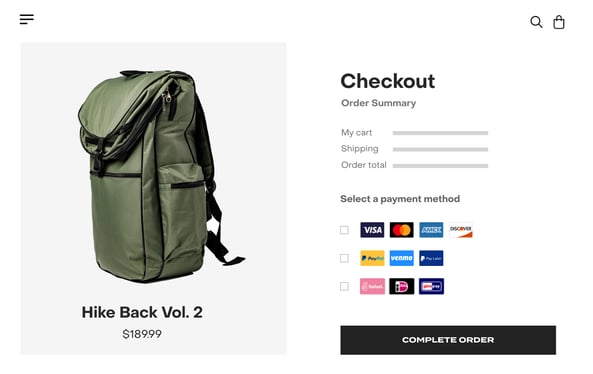By Tony Huynh | December 11, 2021

See why top ecommerce brands use Miva’s no-code platform to run
multiple stores, manage massive catalogs, and grow their revenue.
In 2021, businesses were focused on adapting to continued ecommerce growth and grappling with physical spaces “opening up”. While the year was all about digital transformation, 2022 is going to be more about differentiation and customer expectations. As ecommerce sales in the US surpass $1 trillion in 2022, businesses need to prioritize the customer experience to sustain their momentum and keep a competitive edge.
One way to set up your business for success is to invest in growing areas of ecommerce. In this article, we discuss the 15 ecommerce trends for 2022.
As machine learning technology becomes more sophisticated, brands will begin to leverage AI and automation to enhance the customer experience. Chatbots are an example of this in action—software that can communicate with shoppers via a live chat interface. Chatbots provide instantaneous 24/7 customer service and can act as a resource to lead shoppers to the right pages and keep them coming back to your business.
With voice ecommerce sales predicted to reach $19.4 billion in 2023, we will see businesses continue to incorporate voice shopping to make it even simpler for customers to buy products. Conversational shopping can help you interact with your customers in real-time. Consider experimenting with chat apps like Facebook Messenger and voice technology like Alexa and Siri to allow customers to engage with your business, get recommendations, and even make purchases.

Customers want the option to choose their preferred payment method during the checkout process. Businesses that diversify their payment technology are more likely to build trust, reduce cart abandonment, and encourage shoppers to spend more. Interest-free financing solutions like buy now pay later as well as seamless 1-click payment options will continue to grow in popularity and appeal to shoppers looking for more flexibility with their online shopping.

As with other forms of content marketing, videos are an effective vehicle for marketing your products and attracting new customers. Consider creating and placing videos both on your social media and on key sections of your website like your homepage, about page, or product pages. Unboxing videos, tutorials, explainers, and user-generated content are examples of videos that can resonate with customers and help them make buying decisions.

In 2022, businesses will continue to experiment with new technology to stand out from the competition. Features like product visualizers, product builders, 3D mapping, and augmented reality make it even easier for customers to visualize, explore, and “try out” your products online. This elevated product merchandising helps to recreate that offline retail experience that many shoppers crave while giving them an engaging and easy buying experience.
It goes without saying that ecommerce will only grow more competitive. For many businesses, customer retention is top of mind. We can expect subscription and loyalty programs to continue to grow, providing convenience, exclusivity, and savings to shoppers. This forges a relationship with customers and encourages them to become your brand advocates. 
Omnichannel will continue to expand in 2022. Today’s shoppers value convenience above all else. An omnichannel approach provides that convenience by creating a seamless experience, whether customers are shopping on a desktop, browsing for items on a smartphone, or picking up items via click and collect services in a physical store. Businesses that invest in their omnichannel strategy will be in a better position to maximize sales and spur customer loyalty.
Mobile commerce sales in the US are expected to double between now and 2025. To stay ahead, your business needs to create an easy and engaging experience for mobile shoppers. A solid mobile commerce experience will keep your customers coming back to your business and ensure your sales continue to grow in years to come. Consider including things like push notifications, SMS, mobile content, a mobile ecommerce app, and a mobile-optimized website.
Ecommerce has become the primary customer purchase path for many businesses. As a result, it’s critical for sellers look at and improve every customer touchpoint to remain competitive. To optimize your buyer paths, focus on improving your product search, creating a streamlined mobile experience, providing rich product merchandising, and nailing your fulfillment and return processes.
To thrive as a modern ecommerce business, you need to be able to capture the attention of customers from the get-go and remove any points of friction from the conversion path. Conversion rate optimization is one of many evergreen ecommerce trends that will help online sellers achieve both immediate and long-term results.
More and more people are turning to social media to browse for new products and brands and brands are responding by meeting shoppers where they are. Social commerce sales are projected to reach $79.6 billion in 2025, giving merchants another channel for sales and marketing.
As businesses plan to increase their social media budgets, you’ll want to build out your social strategy. Consider sharing user-generated content to engage followers, partnering with influencers to expand your reach, using livestream shopping to showcase products, and leveraging paid advertising and in-app shopping features to drive sales.
Sustainability is not just reserved for eco-friendly brands and products. As customers increasingly buy from purpose-driven brands, we’ll see more businesses incorporate sustainable practices. These practices will include things like making material changes to products and donating to sustainability-focused organizations.
To connect with today’s conscious customer, you’ll want to make sure your values align with your target customers. This alignment will build trust and drive growth for your business.
Consumers are increasingly flocking to marketplaces, from big-box retailers like Amazon and Walmart to industry-specific, curated websites. This shows a shift in buying preferences toward more convenience and speed that can be offered by these giant marketplaces. Rather than focusing solely on one channel, we will see selling alongside Amazon—they will tap into the wide reach and efficient services of Amazon, while maintaining the control and brand experience of your own website. 
There has been a big shift in B2B selling: the days of paper catalogs and complicated phone orders are being replaced by fully digitalized self-service shopping experiences, streamlined back-end processes, and enhanced customer service. We’ll see B2B businesses upgrading their ecommerce technology and capitalizing on ecommerce trends 2022.
To remain competitive, your B2B business will need to invest in creating online catalogs, offering B2C-like shopping experiences, and providing fast and efficient fulfillment. An effective B2B ecommerce strategy will lead to higher sales volume, increased average order values, and greater customer satisfaction.
The numbers don’t lie: studies show that 80 percent of consumers want more personalization from retailers. By providing a deeper level of personalization, businesses will be able to cater to shoppers based on where they are in the customer journey, giving each visitor individual attention that encourages them to move down the funnel.
Creating a personalized shopping experience is the key to satisfying customers. Shoppers often want help to find the right products and value a more personalized experience that caters to their needs. Ecommerce sites that get onboard with this trend are investing in technology to send personalized pop-ups, follow-up emails, and relevant marketing offers to deliver a better shopping experience and strengthen that bond with their customers.
In 2022, consumers will expect a seamless, convenient, and memorable shopping experience more than ever before. Investing in the right ecommerce trends will allow you to adapt to these fast-changing needs and preferences. To differentiate your business, you’ll want determine which areas in ecommerce are growing and where you could invest in those areas to build better online experiences.
Looking to enhance your digital presence in 2022? Use this 3-minute evaluation to discover new ways to drive sales, differentiate your business, and create an outstanding online experience.

This blog was updated December 11, 2021.
Share this article:
No worries, download the PDF version now and enjoy your reading later...
Download PDF Tony Huynh
Tony Huynh
Tony Huynh is the Senior Content Marketing Specialist at Miva, Inc. Tony is a regular contributor to the Miva blog, covering ecommerce topics like site optimization, ecommerce marketing, and business transformation. He brings to Miva a combination of in-house ecommerce and digital agency experience, with the goal of addressing the needs of online sellers and helping them to succeed online.
Visit Website